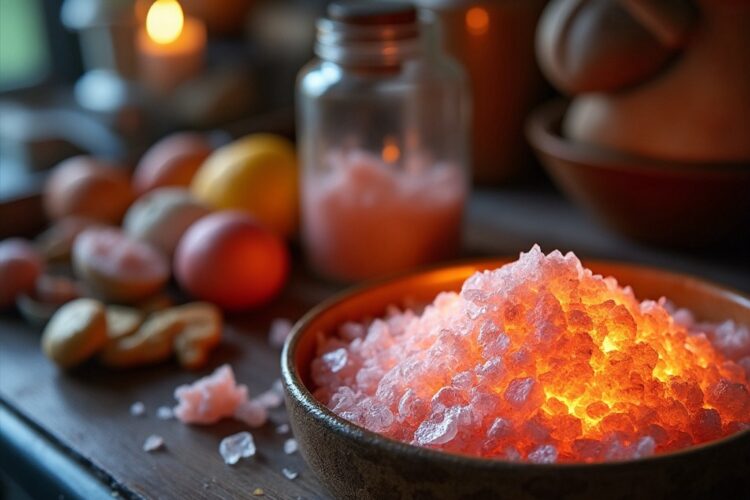Pink Himalayan crystal sea salt has raised concerns regarding potential radiation health risks. While claims suggest it may contain radioactive elements, scientific studies have provided mixed results on the actual levels of radiation. Regulatory standards exist to ensure safe limits. Moderation and dietary balance are important, and alternative salt options are available. Overall, the health risks associated with pink Himalayan salt are inconclusive, but individuals with specific concerns may opt for alternatives or seek professional advice.
Long Version
Pink Himalayan crystal sea salt has gained popularity in recent years as a supposedly healthier alternative to regular table salt. It is marketed as being rich in minerals and free from contaminants. However, there have been claims suggesting that pink Himalayan salt may contain radioactive elements, raising concerns about its potential health risks. In this article, we will explore the topic of radiation in pink Himalayan crystal sea salt and examine the scientific evidence to understand the true extent of the health concerns associated with its consumption.
- Understanding Pink Himalayan Crystal Sea Salt:
Pink Himalayan crystal sea salt is extracted from salt mines located in the Punjab region of Pakistan, near the Himalayan Mountains. It is characterized by its distinctive pink color, which is attributed to the presence of trace minerals, such as iron, potassium, and magnesium. Proponents of pink Himalayan salt argue that it is a healthier option due to its mineral content and lack of additives. - Radioactive Elements in Pink Himalayan Crystal Sea Salt:
One of the primary concerns surrounding pink Himalayan salt is the potential presence of radioactive elements. Some claims suggest that these salts may contain uranium, thorium, and radium, which are naturally occurring radioactive elements found in varying amounts in soil and rocks. It is argued that these elements can accumulate in the salt during the mining process and pose health risks when consumed. - Scientific Evidence and Health Risks:
The presence of radioactive elements in pink Himalayan salt is a legitimate concern. However, scientific studies examining the actual levels of radiation in these salts have provided mixed results. While some studies have detected trace amounts of radioactive isotopes, others have reported negligible levels that are within safe limits for consumption. - Regulatory Standards and Safety:
Regulatory bodies, such as the U.S. Food and Drug Administration (FDA) and the European Food Safety Authority (EFSA), have established maximum limits for the presence of radioactive elements in food products. These limits are designed to ensure public safety and prevent excessive exposure to radiation. Pink Himalayan crystal sea salt, like any other food product, must adhere to these regulations to be considered safe for consumption. - Importance of Moderation and Dietary Balance:
Even if pink Himalayan salt does contain trace amounts of radioactive elements, the overall health risk is likely to be minimal. It is important to remember that the dose makes the poison, and consuming moderate amounts of pink Himalayan salt as part of a balanced diet is unlikely to have adverse health effects. It is crucial to maintain a diverse intake of essential nutrients from various sources rather than relying solely on any specific product. - Alternative Salt Options:
For individuals concerned about the potential risks associated with pink Himalayan crystal sea salt, there are numerous alternative salt options available in the market. These include iodized table salt, sea salt from other sources, and various flavored salts. It is advisable to choose salt products from reputable manufacturers that comply with regulatory standards and provide transparent information about their quality control processes.
Conclusion:
While the presence of radioactive elements in pink Himalayan crystal sea salt is a valid concern, the actual health risks associated with its consumption are currently inconclusive. Existing scientific evidence suggests that the levels of radiation in these salts are generally within safe limits. However, individuals with specific health conditions or those who are particularly sensitive to radiation may consider alternative salt options or consult with a healthcare professional. As with any dietary choice, moderation and balance remain key factors in maintaining a healthy lifestyle.
Doolly Noted
So, Should Humans Worry? No, humans should not worry significantly about the radiation health risks associated with consuming pink Himalayan crystal sea salt.
Words Worth Noting
Pink Himalayan crystal sea salt, radiation, health concern, table salt, mineral content, contaminants, radioactive elements, uranium, thorium, radium, scientific evidence, health risks, regulatory standards, safety, moderation, dietary balance, alternative salt options, FDA, EFSA, maximum limits, dose makes the poison, diverse intake, balanced diet, reputable manufacturers, transparent information, quality control processes, inconclusive, specific health conditions, sensitivity to radiation, professional advice.
Hashtags For Social Media
#PinkHimalayanCrystalSeaSalt #RadiationHealthConcern #TableSalt #MineralContent #Contaminants #RadioactiveElements #Uranium #Thorium #Radium #ScientificEvidence #HealthRisks #RegulatoryStandards #Safety #Moderation #DietaryBalance #AlternativeSaltOptions #FDA #EFSA #MaximumLimits #DoseMakesThePoison #DiverseIntake #BalancedDiet #ReputableManufacturers #TransparentInformation #QualityControlProcesses #Inconclusive #SpecificHealthConditions #SensitivityToRadiation #ProfessionalAdvice






